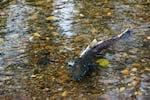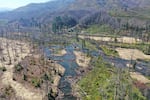The McKenzie River Trust and its partners recently wrapped up their work to restore a 150-acre property called Finn Rock Reach on the McKenzie River. KLCC’s Rachael McDonald spoke with McKenzie River Trust conservation director Eli Tome about the project.
Rachael McDonald: So, can you tell us about Finn Rock Reach and the restoration projects that you’re doing there?
Eli Tome: So McKenzie River Trust purchased that property in an auction in 2016 and we’ve been working with partners up on the McKenzie since then to figure out the best project that we could implement on the ground there that would provide the largest ecological uplift.

More salmon have returned to spawn at Finn Rock since the restoration work began.
Tim Giraudier / McKenzie River Trust
So, we were working very closely with the Eugene Water and Electric Board, the McKenzie Watershed Council and the United States Forest Service up there to look at different design alternatives and figure out how we could best use that property in service to our communities and fish and wildlife species that use river habitats.
So, originally, we were looking at some smaller scale restoration options and by bringing in our partners to the project and thinking a little bit more critically, we started to envision a very large scale river restoration project.
And so we ended up with about 150 acres of the property that has now been converted from, you know, a drier forest, riparian forest, to a river habitat.
So we lowered the floodplain elevations in a lot of areas which allows the water to flow across the property. We added a lot of large wood to the area so that slows the water down. It helps the water filter through the area.
And it also creates amazing salmon habitat. So, the limiting factor for salmon on the Mackenzie River is actually rearing habitat and they need the young salmon when they’re, they’re small and they’re in the river, they need slow moving water areas to protect them in those spring floods.
And so we’ve slowed the water down in the project area by adding large wood by spreading the water out. The McKenzie went from about 100 feet wide in this area to now more than three quarters of a mile wide because we’ve spread it out across our entire property.
McDonald: And how has the salmon responded to this change?
Tome: So, before the project was implemented, we had about nine redds on the property and a redd is a nest that a female salmon makes and lays her eggs in and then a male comes to fertilize the eggs. And so ODFW, the Oregon Department of Fish and Wildlife counted about nine redds per year in that area before the project was implemented. This year in 2023, after the project is done, we’re only about a couple weeks into spawning season, so it’s still early and we’ve already counted 51 redds in the project area. So the salmon have found a new home at Finn Rock.

Work at Finn Rock has widened the river and slowed it down to make habitat for salmon and other wildlife.
Brent Ross / McKenzie River Trust
McDonald: How does the project benefit the area, especially in terms of recent wildfires and, and does it help to, to prevent fires from spreading?
Tome: So when we spread the water out across the flood plain and we make it a more natural condition like it is today. So if we would have gone 400 years ago before Europeans came to the McKenzie Valley, when the land was still stewarded by indigenous folk who called this place home and who stewarded this time since time memorial, it would have been a very complex system. We would have seen water from valley wall to valley wall.
It would have been a really messy system. There would have been riparian vegetation across the entire valley bottom, multiple running channels of water coming through big pools and wetland complexes. Beaver dams everywhere.
It would have been really hard to move through these valley bottoms. In the last 200 years since we’ve had European colonization in the area. We have straightened a lot of rivers and we’ve simplified them to put them into one single-threaded channel because that’s easier to build farms and houses and roads and all the things that people like to have on the landscape that works a lot better if the river stays in one spot in the valley.
So when the river was straightened and was narrowed, that really simplified the environment and that has a detrimental effect on fish and wildlife species.
When we spread that water back out across the valley bottom, and we have created a more natural system there that actually raises the relative humidity and helps lower the temperatures in those riparian corridors which can help as refuge for fish and wildlife during a fire.
So for example, on the south fork of the McKenzie during the Holiday Farm Fire, there was a similar project that had been implemented before the fire and we had wildlife cameras set up to monitor who was using the site.
And a lot of those cameras melted during the fire.
But one of them that survived, we actually caught that a great blue heron came through maybe half an hour or so after the fire moved through the area. And so the banks of the river are still burning, there’s active flames and smoke everywhere and the heron lands in front of the camera to fish.
So we know that these projects can be used as refuge during a fire for fish and wildlife and for birds.
We also know that these projects can be used as fire breaks and Lookout Fire that’s burning on the McKenzie right now, we’ve actually tested that with the Deer Creek restoration site, which again was a very similar type of project where they lowered floodplain elevations.
They added a lot of wood. They slowed the water down, they spread it out across the valley bottom and the lookout fire was advancing eastward. And, it was moving from the HJ Andrews area eastward toward 126. And when it hit the Deer Creek restoration site, it actually stopped the fire. So, it was used as a fire break. And, that’s actually the second time that that project has been tested in 2021.
The Knoll Fire was burning on the McKenzie and it was advancing westward and when it hit the Deer Creek restoration site, it actually stopped. So we know that Deer Creek has been tested twice and so far, two times that it stopped a fire. So these types of restoration projects can be great because they can be used as fire breaks. They can be used as refuge for fish and wildlife during a fire and they’re also a great filter for the river. So after a fire comes through an area like the Mackenzie river, we can expect there to be more sediment that shed into the river.
And then that river, the McKenzie River is Eugene Water & Electric Board’s single source of water supply for Eugene area residents. So it serves over 250,000 people for drinking water. And so these big restoration projects act as filters up river to help trap sediment and other pollutants that might come out of the area after a wildfire.
So we’re helping make a more resilient ecosystem, better able to respond to climate change and other changes in the environment. And it’s helping filter our water and providing a home and refuge for fish and wildlife. And then just, you know, what’s this has been sort of an ongoing project for, for many years in terms of the Finn Rock Reach.
McDonald: So what’s next? What, what happens in the future here at this property?
Tome: So our property, we’re going to, you know, we’re committed to owning it into perpetuity. So, at a land trust, we buy property and we conserve it for fish and wildlife and for our communities and we’re going to be here for a very long time or we’re intending to at least.
And so we are done with the big large scale equipment out there. We shouldn’t have excavators or dump trucks on this anymore, but we will be stewarding it. For example, this winter, we’re going to plant over 260,000 trees and shrubs at the site. And we’re going to be using volunteers to do that through our community members and our membership.
We’re going to be using our staff to plant them and as well as contractors.
So, the work is just beginning really because controlling invasive species including scotch broom, blackberry, all those types of weeds that come up after a big disturbance event. We’re going to be managing those and we’re going to be tending to the plants that we’re planting out there and making sure that the site stays as ecologically beneficial as possible.
McDonald: Is there anything else you’d like to add?
Tome: Yeah, I think the only thing I didn’t mention is that really in the Pacific Northwest, we may only have salmon for another 20 years just based off of a lot of studies that are looking at how climate is changing, how rivers are changing and what habitat is available for these iconic species. And so we really need to be thinking big and thinking about what is the most we can do to help save these iconic species that are so culturally important to those of us who live in the Pacific Northwest.
And so we’re implementing these really big projects up on the McKenzie River. We have planned over 1,700 acres of these big floodplain restoration projects. We’ve already implemented about 400 acres of those and we’re going to be working diligently for the next decade to try and do as much as we can to ensure that our children and our grandchildren here can still experience the magic of salmon.



